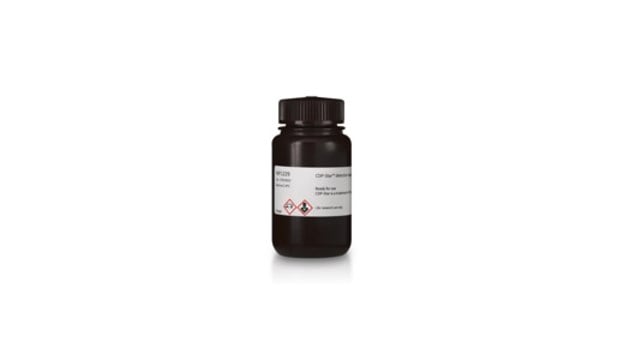12041677001
Roche
CDP-Star®, ready-to-use
>98%, solution, suitable for dot blot, suitable for Northern blotting, suitable for Southern blotting
About This Item
Productos recomendados
description
Disodium 2-chloro-5-(4-methoxyspiro {1,2-dioxetane-3,2′-(5′-chloro)tricyclo[3.3.1.13,7 ]decan}-4-yl)-1-phenyl phosphate
Quality Level
assay
>98%
form
solution
packaging
bottle of 2 × 50 mL ([0.25 mM])
manufacturer/tradename
Roche
technique(s)
Northern blotting: suitable
Southern blotting: suitable
dot blot: suitable
storage temp.
2-8°C
Categorías relacionadas
Publishing
Application
- Southern blot
- Northern blot
- Dot blot
- Colony and plaque hybridization
- Gel shift assays
- Southern blot
- Northern blot
- Dot blot
- Colony and plaque hybridization
- Gel shift assays
- Chemiluminescent detection.
Features and Benefits
0.25 mM solution (0.124 mg/ml), ready-to-use, colorless solution
- Save time with a fast, ultra-sensitive substrate.
- Easily strip and reprobe membranes.
- Take multiple exposures of up to two days for each experiment.
Preparation Note
Maleic Acid Buffer: 15 to 25 °C, stable
Detection Buffer: 15 to 25 °C, stable
Blocking Solution: always prepare freshly
Antibody Solution: 2 to 8 °C
Other Notes
- First exposure to X-ray film should be 5-15 minutes. Examine film and then determine other exposure times based on initial result.
- No preincubation step required.
- Apply substrate quickly to avoid gray shadows from substrate drops and drying of membrane (leads to uneven, high background).
- Do not use plastic wrap to cover blot; use hybridization bags, acetate sheet protectors, or two sheets of transparent film.
- Exposure times are shorter than with CSPD.
- Do not use nitrocellulose membranes.
Legal Information
Storage Class
12 - Non Combustible Liquids
wgk_germany
nwg
flash_point_f
does not flash
flash_point_c
does not flash
Certificados de análisis (COA)
Busque Certificados de análisis (COA) introduciendo el número de lote del producto. Los números de lote se encuentran en la etiqueta del producto después de las palabras «Lot» o «Batch»
¿Ya tiene este producto?
Encuentre la documentación para los productos que ha comprado recientemente en la Biblioteca de documentos.
Los clientes también vieron
Nuestro equipo de científicos tiene experiencia en todas las áreas de investigación: Ciencias de la vida, Ciencia de los materiales, Síntesis química, Cromatografía, Analítica y muchas otras.
Póngase en contacto con el Servicio técnico




![CSPD ready-to-use Disodium 3-(4-methoxyspiro {1,2-dioxetane-3,2′-(5′-chloro)tricyclo [3.3.1.13,7]decan}-4-yl)phenyl phosphate](/deepweb/assets/sigmaaldrich/product/images/352/091/ef743cea-ccd8-44f1-8f3b-dec5a1e4f5d1/640/ef743cea-ccd8-44f1-8f3b-dec5a1e4f5d1.jpg)




